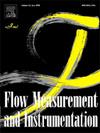Determination of flow angle from measurements of vortex shedding frequency downstream of a triangular bluff model using a single-sensor hot-wire probe
IF 2.3
3区 工程技术
Q2 ENGINEERING, MECHANICAL
引用次数: 0
Abstract
Experimental aerodynamic studies often require precise measurements of flow angles. However, the conventional multi-hole probe is unsuitable for measuring small flow angles or for use under low-velocity conditions. To overcome these limitations, a new method has been proposed based on measuring the frequency of vortex shedding downstream of a non-polar symmetric body. This technique utilizes a single-sensor hot-wire probe to measure the frequency of the vortex shedding from an equilateral triangular model at different flow angles ( by rotating the model using a rotating mechanism. Subsequently, the Strouhal number (St) is determined for each flow angle from the measured vortex shedding frequencies. An empirical correlation is then obtained between the Strouhal number and the flow angle of the form , considering the condition where the Strouhal number is solely a function of the flow angle. The range of flow angles for which the proposed method is applicable, along with acceptable repeatability of the vortex shedding frequency and suitable Strouhal number sensitivity to the variations in the flow angle, was determined. An empirical correlation was established, which can be used to determine flow angles in the range of ±10° with an accuracy of 1°. For this purpose, the triangular model is fixed at an angle of 33° to the principal coordinates. The probe is positioned downstream of the model in the defined range: , , where is the side of the equilateral triangular model, and and are probe distances in the flow and perpendicular to the flow direction.
利用单传感器热线探头测量三角崖模型下游的涡流脱落频率确定流角
空气动力学实验研究通常需要精确测量流动角。然而,传统的多孔探头不适合测量小的流角,也不适合在低速条件下使用。为了克服这些限制,我们提出了一种基于测量非极性对称体下游涡流脱落频率的新方法。该技术利用单传感器热线探头,通过旋转机构旋转等边三角形模型,测量模型在不同流角 (α) 下的涡流脱落频率。随后,根据测量到的涡流脱落频率确定每个流动角度下的斯特劳哈尔数 (St)。考虑到斯特劳哈尔数仅是流角函数的情况,斯特劳哈尔数与流角之间的经验相关性为 α=f-1(St)。确定了建议方法适用的流角范围,以及可接受的涡流脱落频率重复性和合适的斯特劳哈尔数对流角变化的敏感性。建立了经验相关性 α=-4153.4St2-1819.9St+189.51,可用来确定 ±10° 范围内的流动角,精度为 1°。为此,三角形模型与主坐标固定成 33°角。探头位于确定范围内模型的下游:3≤x/a<25,4.5≤y/a≤5.1,其中 a 是等边三角形模型的边长,x 和 y 是探头在水流中与水流方向垂直的距离。
本文章由计算机程序翻译,如有差异,请以英文原文为准。
求助全文
约1分钟内获得全文
求助全文
来源期刊

Flow Measurement and Instrumentation
工程技术-工程:机械
CiteScore
4.30
自引率
13.60%
发文量
123
审稿时长
6 months
期刊介绍:
Flow Measurement and Instrumentation is dedicated to disseminating the latest research results on all aspects of flow measurement, in both closed conduits and open channels. The design of flow measurement systems involves a wide variety of multidisciplinary activities including modelling the flow sensor, the fluid flow and the sensor/fluid interactions through the use of computation techniques; the development of advanced transducer systems and their associated signal processing and the laboratory and field assessment of the overall system under ideal and disturbed conditions.
FMI is the essential forum for critical information exchange, and contributions are particularly encouraged in the following areas of interest:
Modelling: the application of mathematical and computational modelling to the interaction of fluid dynamics with flowmeters, including flowmeter behaviour, improved flowmeter design and installation problems. Application of CAD/CAE techniques to flowmeter modelling are eligible.
Design and development: the detailed design of the flowmeter head and/or signal processing aspects of novel flowmeters. Emphasis is given to papers identifying new sensor configurations, multisensor flow measurement systems, non-intrusive flow metering techniques and the application of microelectronic techniques in smart or intelligent systems.
Calibration techniques: including descriptions of new or existing calibration facilities and techniques, calibration data from different flowmeter types, and calibration intercomparison data from different laboratories.
Installation effect data: dealing with the effects of non-ideal flow conditions on flowmeters. Papers combining a theoretical understanding of flowmeter behaviour with experimental work are particularly welcome.
 求助内容:
求助内容: 应助结果提醒方式:
应助结果提醒方式:


